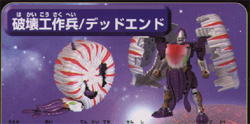 BEAST
WARS: TOY REVIEW
BEAST
WARS: TOY REVIEW
Name: DEAD END
Allegiance: Destron
Function: Demolition
Beast Modes: Ammonite
Average Price: 780 JPY

BEAST MODE
Dead End is an Ammonite (a prehistoric invertebrate; imagine a snail, but with a cuttlefish’s head), about 13 cm from the tip of the tentacles to the back of the shell, primarily coloured iridescent white and purple, with pink and gold highlights and green eyes. There are jagged holes on either side of the shell, presumably to look like battle damage, which give exciting glimpses of the robot parts hidden within, which gives the toy a visual dynamic it might look a little boring without. Unusually, this beast mode has no articulation whatsoever. The difficulty with prehistoric beast modes is gauging how much the toy looks like the ‘real thing’. Aside from the sides of the shell being quite flat, giving the shell an artificial wheel-like appearance, what detail there is okay, with crenellations on the shell, gold ‘teeth’, and ridges on the tentacles.
TRANSFORMATION TO ROBOT MODE
Start by pushing the purple button on top of the shell; this will cause the right side of the shell to pop off (this is also the toy’s Attack feature). This will expose the robot parts within. Swing the arms out from the shoulders, then pivot the shell holders on top of the arms outward. Uncurl the legs from within the shell. Swing the ammonite head down between the robot legs, around the back, and then over the top to form the robot’s chest. Rotate the robot head to face the front, and replace the removable shell-half back in its launcher. The robot’s gun is the two large removable tentacles, situated beneath the main body of tentacles.
ROBOT MODE
Dead End, like most Basic beasts, stands about 11 cm high. In this mode, he also adds gold highlights on his fists and legs. His head has a wide mouth with sharp teeth, large red eyes, and also incorporates elements of the beast mode head, with tiny purple tentacle sprouting from the back like hair. The beast mode head forms the chest, and the tentacles hang down to form a ‘sporran’. The shell halves form two large shields on either side of the robot mode, both of which are removable. I like the balance that these ‘shields’ bring to the toy.
SPARK CRYSTAL LOCATION
The Spark crystal is located on the right-side shoulder mounted shell launcher, visible from the front in robot mode.
OVERALL
I’m fond of this toy, as it brings an insight into a slightly different paradigm of toy marketing and manufacture to bear. For instance, the US version of this toy would never have used this combination of colours, which are quite lurid, and unlikely to be found in this combination in nature! The choice of colours adds to the Japanese feel of the toys (which is, after all, the intended market), and I find that stimulating. Also, the beast mode is less of an immediately dangerous or threatening animal, which most of the US toys use. By the choice of beast mode, the Japanese designers have bestowed a more subtle character upon Dead End than the ‘smash ‘em bash ‘em’ type animal we are used to.
My main complaint is that the use of iridescent plastic and the choice of colours make the plastic look cheaper than on other BW toys, even though it is doubtless of the same grade. The transformation is quite complex for such a small toy (almost frustratingly so!), providing a great challenge and much enjoyment.
This toy review was written by Wayne Bickley.
BEAST TRIVIA
Although relatively simple in form, ammonites are extremely rich in the information they yield to scientists. These extinct marine animals, which thrived in the Paleozoic and Mesozoic Eras, some 400 to 65 million years ago, were cephalopods, and are thus related to squid, octopus, cuttlefish, and the chambered nautilus.
Ammonites were able to swim, thanks to the unique construction of their shell, which was divided into a series of air chambers. The air in the chambers provided buoyancy for the animal to float; like modern cephalopods, they probably moved through the water using jet propulsion.
Fossils of ammonites are found all over the world. As different species of ammonites lived during different time periods, scientists can use these animals to determine the relative age of the rocks in which their fossils are found (such fossils are called "index fossils"). Because ammonites lived exclusively in marine environments, their presence also indicates the location of prehistoric seas.
Many ammonites preserve their original shell material and are quite beautiful. Scientists are currently studying the evolution and life history of these ancient creatures.
Bibliography: American Museum of Natural History
Email
Back
 BEAST
WARS: TOY REVIEW
BEAST
WARS: TOY REVIEW